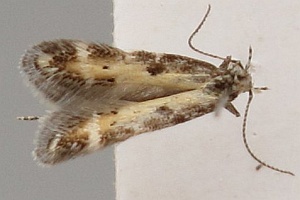

 +2Kontinente:EU
+2Kontinente:EU2. Diagnose
2.1. Männchen
3. Biologie
3.1. Nahrung der Raupe
Noch unbekannt! Die Autoren der Erstbeschreibung schreiben aber: "Adults were collected in May and in August during the day (early morning or before sunset) in salinesteppes biotopes dominated by Limonium meyeri (Boiss.) O. Kuntze (Limoniaceae), which is a possible larval host plant."
4. Weitere Informationen
4.1. Etymologie (Namenserklärung)
Bidzilya & Budashkin (2015) teilen mit: "New specific name is derived from the Latin confus – confused, in reference to our long confusion of this species with A. brizella.
4.2. Taxonomie
Die Art wird mit Aristotelia staticella, verglichen, genetisch noch näher (Abstand beim Barcoding: 1,8 %) ist Aristotelia brizella.
4.3. Typenmaterial
Bidzilya & Budashkin (2015) schreiben: "Holotype ♂, Crimea, Yuzhnoye Prisivashje, okr. Lvovo, 17.v.2013 (Budashkin) (ZMKU). Paratypes: 1 ♂, same data as holotype but 23.v.2013 (gen. slide 201/14, O. Bidzilya); 1 ♂, same data but 26.v.2013; 1 ♀, Crimea, Evpatoria, 23.viii.2005 (Puzanov) (gen. slide 59/07, O. Bidzilya); 1 ♀, Ukraine, Zaporozhie vic., Gadjuchia balka, 19.v.1991 (Zhakov); 1 ♂, 1 ♀, Ukraine, [Donetsk reg.] Khomutovskaya step, 18, 23.v.2006 (Bidzilya) (gen. slide 46/13♂, O. Bidzilya) (all ZMKU)."
4.4. Faunistik
Die Art ist bisher nur durch die Typenserie von der Ostukraine und der Krim bekannt.
(Autor: Erwin Rennwald)
4.5. Literatur
- Erstbeschreibung: Bidzilya, O.V. & Y.I. Budashkin (2015): New species of Gelechiidae (Lepidoptera) from Ukraine. — Zootaxa 3974 (2): 217–230. [http://dx.doi.org/10.11646/zootaxa.3974.2.6]. [zum Preview und Zugang zur Originalarbeit auf mapress.com]





